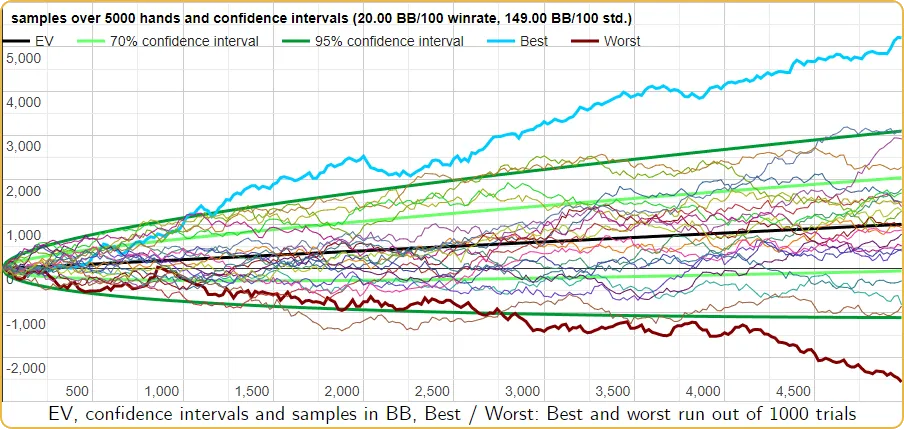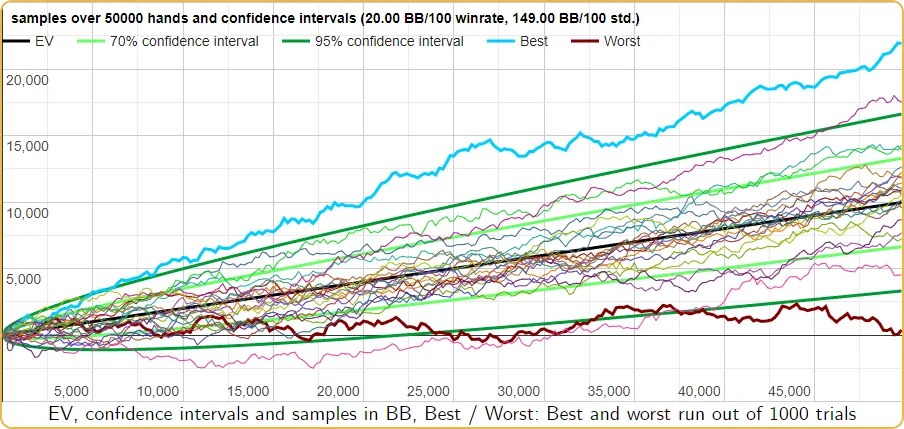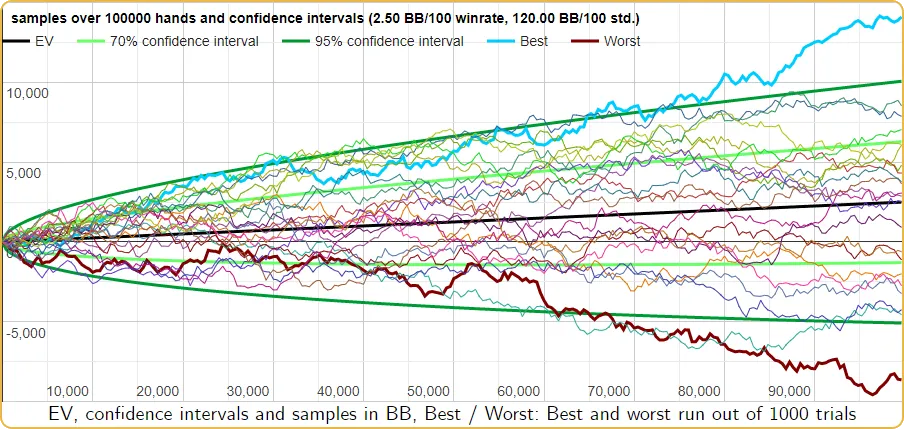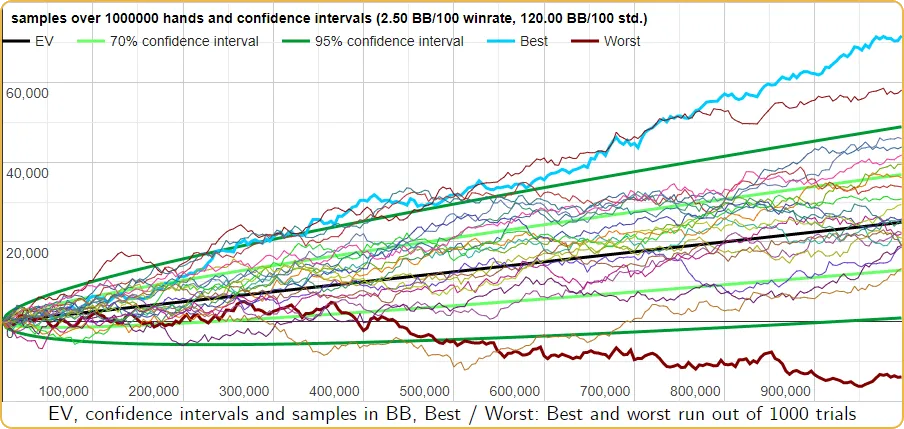Variance in Poker – what is it, what’s the point, and why do I need it? This article aims to explain what variance is using examples and to demonstrate that online poker players can generally expect wilder swings than live poker players.
What is Variance?

Variance is not a dirty word, but for most people, it’s a relatively undefined concept. It involves a small dose of mathematics, the same science that makes our cars run, our smartphones work, and our satellites not fall from the sky. Even without ever having heard of normal distributions or the central limit theorem, variance in poker can be explained through examples. Let’s do just that!
First, let’s take a fictional professional live cash game player who plays an average of 20 days per month and around 8 hours per day. On average, they see between 30 and 35 hands per hour, resulting in around 5,000 hands per month.
Assuming this player plays $2/$5 and regularly makes a profit, they earn $5,000 per month from playing poker. Their win rate is, therefore, $100 per 100 hands, or 20 big blinds per 100 hands.
Of course, they don’t win their money evenly; they have good and bad days. These “good and bad days” are the variance. Variance can be expressed in numbers, and it’s common to use the average deviation from the win rate per 100 hands as a measure of variance. This is called the standard deviation per 100 hands.
Suppose the live player records their results every 100 hands and comes up with the following table after 5,000 hands:
| -$1,150 | $809 | -$124 | -$953 | -$1,038 | -$607 | $1,157 | -$421 | -$673 | $352 |
| -$963 | $628 | $195 | $557 | -$268 | -$43 | $866 | -$992 | -$190 | -$419 |
| -$798 | -$422 | $1,210 | $926 | $45 | -$985 | -$917 | -$367 | $476 | -$621 |
| $19 | $1,225 | $944 | -$841 | $248 | $781 | $57 | $72 | $331 | $194 |
| $379 | $904 | $1,156 | $1,177 | $906 | $757 | $1,219 | -$858 | -$35 | $1,095 |
These numbers add up to $5,000 (1,000 big blinds), and with some effort, you can calculate the standard deviation: $745. In other words, on average, the player will miss their $100 per 100 hands win rate by around $745.
Variance in Live Cash Games
With these two measures, win rate (20 big blinds / 100 hands) and standard deviation ($745 or 149 big blinds / 100 hands), we have all the tools we need to estimate how the live player will perform in future games, how much bad luck is possible, and how confident they can be in making a profit over a certain period.
Simply go to my variance calculator, enter the two values, and let the calculator simulate the game over 5,000 hands.
The simulator then shows what results are possible over this period:

The bold green lines show the so-called confidence intervals. The light green line encloses the 70% interval – the probability that the winnings will fall within these lines is around 70%. The dark green line shows the 95% interval. The probability that the winnings will fall within this interval is 95%.
The variance simulator shows a lot more information:
- The probability of this player not making any profit over 5,000 hands is 17.1%.
- During approximately 24% of the player’s gameplay time, they will experience a downswing of more than 1,000 big blinds ($5,000).
- During approximately 5 to 6% of the player’s gameplay time, they will experience a downswing that lasts more than 20,000 hands (which equals at least four months with 5,000 hands played per month).
The simulator can also calculate a longer period of time, for example, 10 months or 50,000 hands:

All graphs are now curving up nicely. The probability of this player losing over a period of 50,000 hands is only 0.13 percent.
Excellent players do not have major variance problems.
The example above of a player winning 20 big blinds per 100 hands in live cash games shows that after a few months, they will almost certainly overcome any variance. They win so much that they still show a profit even during larger downswings.
However, as the sole source of income, this player should not necessarily rely on live poker exclusively. The simulation also shows that on average, they will lose money approximately every sixth month.
Variance in online poker
Next, let’s take a look at the variance in online poker. Many more hands are played online, and the standard deviation is often a little lower compared to live poker games. A lower standard deviation means lower variance. So, does variance have less of an impact online?
The problem online is that by no means are the same win rates possible as in live poker. Our live player in the above example won 20 big blinds per 100 hands. However, a win rate of 2.5 big blinds per 100 hands is already considered good online.
A lower win rate has drastic effects on variance.
Let’s take an example player again. This player plays online with blinds of $1.00 / $2.00 and has a win rate of $5 per 100 hands (2.5 big blinds). This player plays for 20 days per month and around 5,000 hands per day – so 100,000 hands per month. Therefore, they, like the live player above, have an average monthly profit of $5,000.
The standard deviation for this player is 120 big blinds per 100 hands (this value can be read from all common tracking programs).
So, let’s let the variance simulator calculate with a win rate of 2.5 big blinds / 100 and a standard deviation of 120 big blinds / 100:

The graph doesn’t look too different from the live player over 5,000 hands, but still, the variance is notably bigger in the online case.
- The probability that this online player will lose over 100,000 hands is roughly 25 percent.
- This player is stuck in a downswing of more than 5,000 big blinds ($10,000) about 48 percent of the time – virtually half the time they’re playing.
- This player is on a downswing that lasts at least 100,000 hands for over 50% of their playing time.
- This player experiences a downswing of at least 750,000 hands (i.e., seven and a half months with 100,000 hands played per month) in about 12 – 13 percent of their playing time.
But if the player plays for 10 months, that is, a total of 1,000,000 hands, the variance also looks much friendlier:

However, even after 1,000,000 hands, the possible results of this player are still very widely spread. Their 95% confidence interval is $4,000 to €98,000, meaning that in 5% of cases, they will have won either more than €98,000 or less than €4,000 after a million hands.
Variance is a Bitch
The example of the online player shows that variance can have very drastic effects if you don’t have a god-like win rate.
In live poker, massive win rates are possible for very good players because the competition is significantly worse. Online, however, the 2.5 big blinds per 100 hands used in this example are already considered a decent value.
To consistently and reliably earn money in online cash games despite the variance that comes with it, you must work at a relatively high pace. In our example, the online player played 20 times as many hands as the live player and still struggled with more intense variance.
As a final example to illustrate the relevance of game volume, let’s look again at the online player (2.5 BB/100 win rate and 120 BB/100 standard deviation) and see how likely it is that they will lose depending on how many hands they play:
| Hands | Probability of losing |
|---|---|
| 5,000 | 44% |
| 20,000 | 38% |
| 100,000 | 26% |
| 250,000 | 15% |
| 500,000 | 7% |
| 1,000,000 | 1.8% |
| 1,500,000 | 0.5% |
This means if 100 of these players sit down and each play only 5,000 hands, 44 of them would lose – even though all of them are good players. And if 200 players sat down and played 1,500,000 hands – that is 15 months of nonstop play at 100,000 hands per month – one of the players would still lose money despite being as good as the other 199 players.
Consistently Winning at Online Cash Games Requires Endurance
For beginners, these numbers can be a bit confusing, but they essentially say the following: When playing online poker, you cannot sit down for a few hours a day, play one or two tables, and expect to regularly make a profit. Anyone who expects this will definitely not be happy with online poker.
Anyone who seriously wants to earn money with online cash games must be willing to play a significant amount. Otherwise, the variance will eat you alive sooner or later.
Also, you should not underestimate downswings and upswings in online poker. They occur constantly and are usually much larger than intuitively expected. Just because you won 10 buy-ins in a few hours doesn’t mean you’re the next online poker prodigy. On the other hand, just because you lost 10 buy-ins in a few hours doesn’t mean you’re a catastrophic player or being cheated.
Even those who play online poker on the lowest limits or for purely competitive reasons must be prepared for the fact that they may need a lot of endurance to consistently beat a limit.
Fortunately, variance can just as well swing upwards, and even a beginner can win a Sunday Major, for example. But hoping for a lucky punch is something completely different than playing poker seriously.
Video: Understanding Poker Variance and Downswings
Relevant Resources
» Cashgame Variance Calculator
» Tournament Variance Calculator
